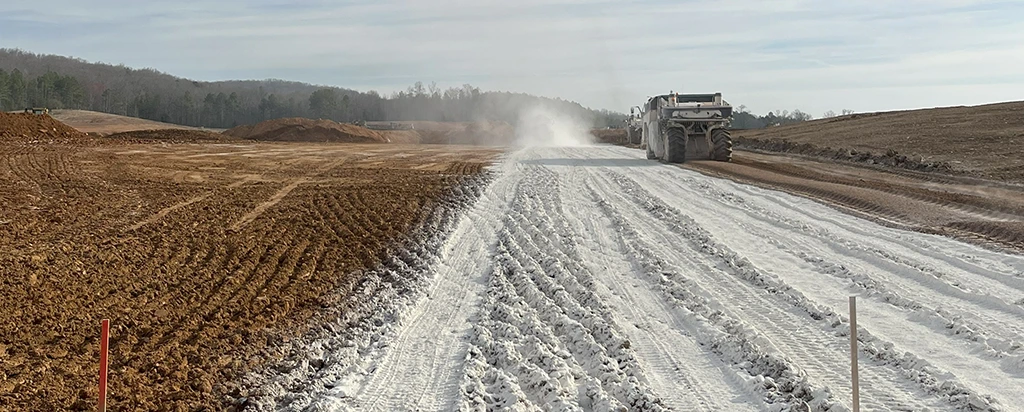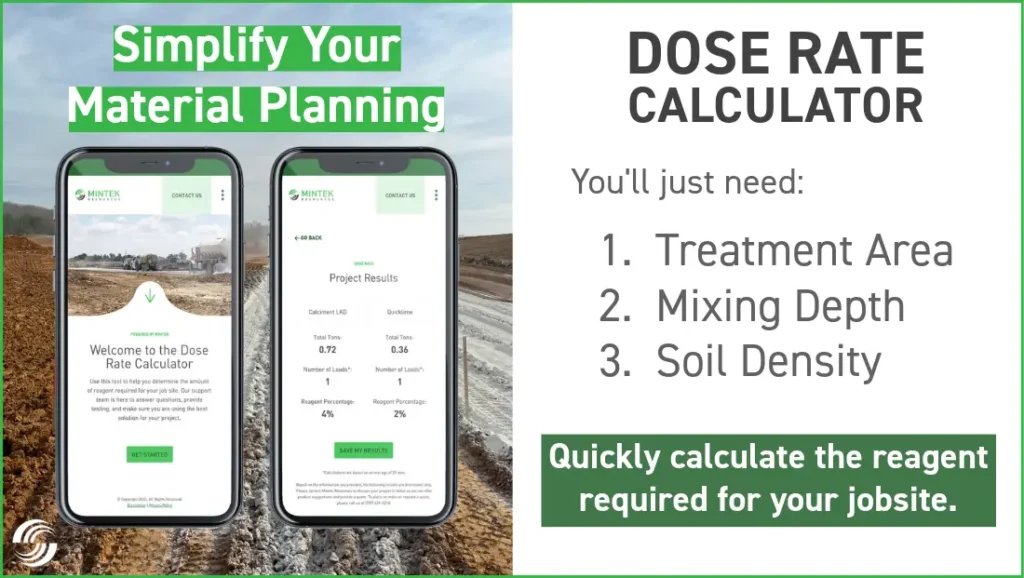Save Time and Money with Mintek’s Lime Stabilization Calculator

Lime stabilization turns challenging soils into durable foundations suitable for the construction industry. When lime-based reagents interact with soil, a chemical process alters its characteristics – binding clay particles, reducing plasticity & shrink-swell potential, drying overly wet soils, and significantly increasing load-bearing capacity. This creates a strong, reliable base for roads, buildings, and other infrastructure.
Instead of hauling away truckloads of unsuitable soil and bringing in new material, lime stabilization transforms what’s already there. The savings add up quickly – less excavation, reduced trucking, far less disruption to your workflow and the surrounding environment, and reduce, if not eliminate, disposal and borrow fees.
Our Dose Rate Calculator is designed to help forecast the application rates your soil needs for your unique conditions, eliminating guesswork and ensuring efficient use of resources, so your project stays on track.
Get back to work with less downtime.
Reasons to Use a Lime Stabilization Calculator
Our lime stabilization calculator is a convenient tool designed to streamline the planning process for your soil treatment projects. By inputting soil data and project specifications, the calculator provides an estimate of the amount of Quicklime, CQL, or Calciment® LKD required, giving you the numbers needed to move forward with confidence.
Key benefits include:
- Time Savings: Eliminate guesswork and reduce the time spent manually calculating quantities, so you can focus on your project’s execution.
- Planning Confidence: Quickly generate reliable estimates for total tons needed and application rates.
- Resource Efficiency: Anticipating project needs in advance helps reduce waste in labor hours, equipment operation time, and materials while potentially accelerating your schedule.
- Improved Project Outcomes: Properly calculated lime application ensures the soil reaches its target engineering properties—strength, stability, plasticity reduction, etc. This translates to extended pavement life, reduced maintenance requirements, and greater infrastructure resilience.
Dose Rate Calculator Guide

To get started with the Dose Rate Calculator, you’ll need a few key details about your project:
Treatment Area
Specify the area (in square feet or square yards) to be treated. This is the total surface area where soil drying, modification, and/or stabilization is required.
Mixing Depth
Specify how deep lime-based reagents will be mixed into the soil (in inches or feet). Refer to project specifications or consult engineers, and ensure the depth aligns with equipment capabilities.
Soil/Sediment Density
Provide the density of the soil (usually in pounds per cubic foot or pounds per cubic yard). Soil density can be determined using standard geotechnical tests or by referencing local soil data.
Product Selection
Choose between Quicklime/CQL and Calciment® LKD – or compare both. While either may be suitable for your project, each has distinct properties that may be better suited to specific soil conditions and project requirements. If you’re unsure, reach out to us for expert guidance. Our team is ready to provide tailored solutions to meet your project’s unique needs.
After making your selections, the calculator will tell you the total tons of lime-based product required, an estimate of the number of truckloads needed, and the final application rate tailored to your soil stabilization project. The recommended dosage rates automatically populate for your convenience, but you can adjust them as needed to fit the specific requirements of your project. You can then download these results as a PDF or have them emailed to you for convenience.
Other Factors That Influence Lime Stabilization Calculations
Every lime stabilization project is unique, and while our Dose Rate Calculator equips you with accurate application rates to prepare effectively, it’s important to also consider other factors that may impact your approach.
These include:
- Soil Composition: The type of soil you are working with greatly influences lime requirements. Depending on the desired outcome, soil modification or stabilization, one lime-based product may perform better than another. If you’re unsure, please contact us for guidance to ensure the lime treatment achieves the desired results based on your soil’s unique characteristics.
- Moisture Content: Wet or dry soils may need additional adjustments before lime treatment. In overly wet conditions, lime-based products are the best drying solution. Our applications experts can guide you through balancing moisture conditions to achieve optimal results.
- Project Requirements: Your specific project needs influence lime application rate calculations. Factors such as required bearing capacity, unconfined compressive strength, maximum plasticity index (PI), shrink-swell concerns, expected loads, moisture content, and projected service life all play a role in determining the appropriate treatment levels.
- Environmental Conditions: External factors add another layer of complexity. Temperature affects reaction rates, with colder conditions typically slowing the chemical processes that drive stabilization. Lime-based products will react exothermically to help soils cure as they would in warmer conditions. This is a huge benefit when considering cement stabilization in cold conditions.
Our experienced sales and applications teams are here to help address these variables, offering tailored solutions to ensure your soil stabilization efforts are effective and efficient.
Ready to stabilize your soil and your project schedule? Give us a call to see how Mintek can help you build from the ground up.
FAQs
What factors affect calculating lime application rates for my soil?
Several factors influence lime application rates, including the soil’s type, plasticity, moisture content, and the project’s target strength requirements. Each of these components play a role in determining the appropriate application rate to achieve effective soil stabilization.
How does soil classification influence lime requirements?
The type and plasticity of soil play a crucial role in selecting the appropriate soil stabilizer and meeting project requirements. Cement stabilization is typically well-suited for sandy soils, whereas lime-based products are often preferred as clay content and plasticity increase. We strongly encourage testing to help determine the expected result for each material.
Does calculating lime application depend on the specific product being used?
Yes. Different lime products have varying reactive calcium oxide (CaO) content, which directly affects application rates. Quicklime, CQL, and Calciment® LKD have different specifications. Our calculator adjusts for these differences, ensuring you get accurate results regardless of which product you select.
About Mintek Resources
Since 1994, project owners across the country have trusted Mintek to deliver reliable lime-based reagents that get the job done right. We bring unmatched technical expertise to every job site, helping you select the right product and application rate for your specific soil challenges. The Mintek difference isn’t just about what we provide – it’s about the way we partner with you. As your trusted partner, we focus on solving problems to save you time and money, ensuring success every step of the way.
We have a distribution network spanning 29+ states, backed by technical and customer support teams, along with flexible delivery options. Our lime stabilization calculator is one of the many resources we offer to simplify planning and enhance project efficiency.
We're here to help you find the best solution for your next project. Let's get started. Give me a call at 937-641-9901.

Josh Weser
Mintek Resources
Related Posts
Unlocking Pavement Potential: The Long-Term Value of Chemically Stabilized Subgrades
A Foundation in Crisis America’s roadways are the backbone of its economy and daily life, yet they continue to show signs of chronic underinvestment. According to the American Society of Civil Engineers’ 2025 Infrastructure Report Card, the nation’s infrastructure...
Ground Control: Comparing Lime and Geosynthetics for Long-Lasting Stability
When building infrastructure on weak in-situ soils, a well-designed foundation is essential to ensure long-term resilience. Whether you're constructing roads, embankments, or industrial platforms, ensuring subgrade stability is critical—not just for performance, but...
Exploring The Application of Lime Stabilization in Soil
Creating a stable foundation is essential for any construction project, yet many construction sites face challenges with unsuitable soil conditions. Lime soil stabilization offers a proven, cost-effective solution for transforming problematic soils into reliable...